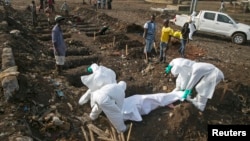Medical detective work will be the next big phase in the fight against Ebola when the United Nations deploys hundreds of health workers to identify chains of infection as the virus passes from person to person, top U.N. health workers said.
The health teams will travel to each district and region of Guinea, Sierra Leone and Liberia, the three countries at the center of the epidemic, to trace who each infected person has potentially contacted.
The effort will run in parallel with measures to minimize the spread of infection, such as treating all Ebola patients in specialized centers and burying all victims safely.
Ebola Claimed 1st Victim a Year Ago
Ebola Claimed 1st Victim a Year Ago
It was a year ago that the Ebola crisis in West Africa that claimed its first victim, and the outbreak is likely to last until the end of 2015, said Peter Piot, director of the London School of Hygiene and Tropical Medicine and part of a team to discover Ebola in 1976.
“This will be an epidemic with a very long tail, and a bumpy tail. ... We need to be ready for a long effort, a sustained effort probably the rest of 2015,” Piot told the BBC on Wednesday.
On December 28, 2013, 2-year-old Emile Ouamouno died in the remote village of Meliandou in southern Guinea after suffering from a fever, headache and diarrhea. His 3-year-old sister, mother and grandmother died days later.
These deaths went unnoticed and the disease smoldered undetected, according to the WHO. It was not until March that health officials in Guinea started to realize something worrisome was happening.
As of Wednesday, the death toll from Ebola in Liberia, Sierra Leone and Guinea - the three West Africa countries hardest hit by the epidemic - has risen to 7,573 out of 19,463 confirmed cases recorded there to date, the World Health Organization reported.
Material for this article came from Reuters.
Phase Two of plan
But Phase Two of the plan is to contain the virus by understanding its lines of transmission, said World Health Organization Director-General Margaret Chan.
“You chase the virus. You hunt the virus. The virus lives in an infected person so you chase every case, isolate them and then all the people who come into contact with the infected person,” Chan told Reuters on a visit to West Africa.
She was accompanying U.N. Secretary-General Ban Ki-moon on a four-country tour to encourage health workers and focus global attention on the fight against the epidemic.
The world's worst Ebola outbreak has killed 7,573 of 19,463 confirmed cases, according to WHO figures on Wednesday, though the number of new cases is slowing in most places.
Chains of transmission
The disease spreads through contact with an infected person or corpse, so family members who care for patients or people who prepare victims for burial are at risk.
As a result, people often know how they fell ill. Patients who say they do not know are a concern because their cases can signify chains of transmission yet to be identified, Chan said.
“You don't have control of Ebola until you know where all your transmission chains are and until your cases are coming from known contact lists,” said Bruce Aylward, WHO's head of Ebola response.
“You always hear about disease detective work and that is what Ebola is about now,” he said. Contact-tracing involves visiting households to pick up signs of illness, and requires cooperation from local authorities and community leaders.
Illustrating the scale of the challenge, 25 percent of new cases in Liberia are coming from new sources, Aylward said. By contrast, officials in Guinea said in November all the cases in the capital stemmed from just four chains of transmission.
The overall cost of the Ebola response could rise to around $4.1 billion, said U.N. Special Envoy on Ebola David Nabarro.
To accomplish Phase Two, the U.N. health agency will mobilize 900 epidemiologists, triple the number currently available, he said. Around half will be foreigners.
The aim is to get teams in place by the end of January, following a separate plan to get all patients treated and all victims safely buried by the end of this month.











